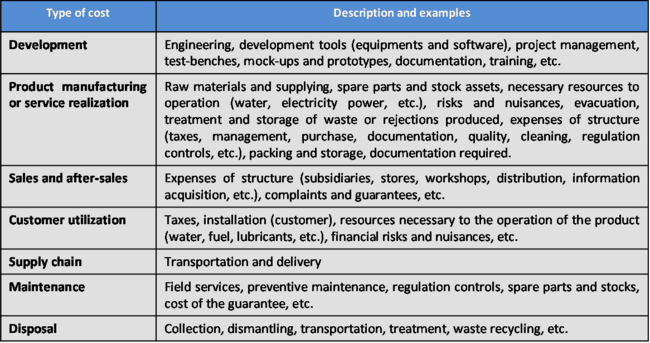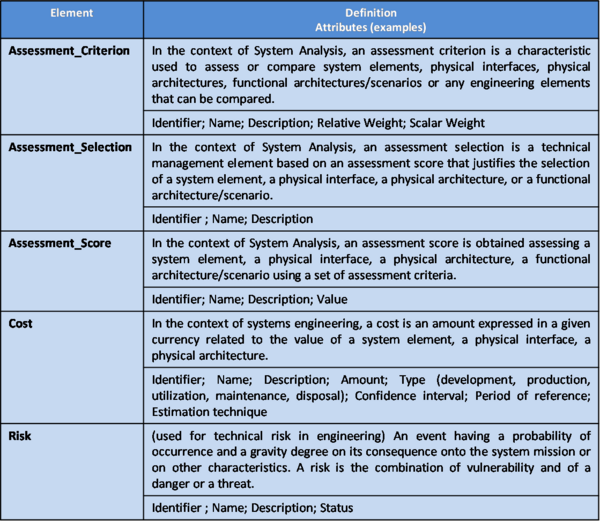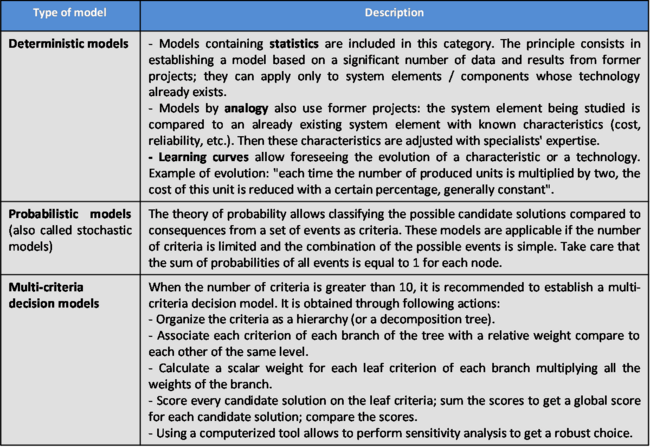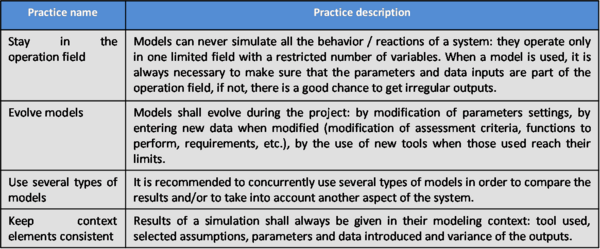Difference between revisions of "System Analysis"
Afaisandier (talk | contribs) |
Afaisandier (talk | contribs) |
||
| Line 159: | Line 159: | ||
===Additional References=== | ===Additional References=== | ||
| − | |||
Ring, J, H. Eisner, and M. Maier. 2010. "Key Issues of Systems Engineering, Part 3: Proving Your Design." INCOSE ''Insight'' 13(2). | Ring, J, H. Eisner, and M. Maier. 2010. "Key Issues of Systems Engineering, Part 3: Proving Your Design." INCOSE ''Insight'' 13(2). | ||
Revision as of 16:13, 31 July 2012
System analysis allows the developers of systems to carry out (in an objective way) quantitative assessments in order to select and/or update the most efficient System Architecture and to generate derived engineering data.
During engineering, assessments should be performed every time technical choices or decisions are made, to determine compliance with System Requirements. System analysis provides a rigorous approach to technical decision-making. It is used to perform trade-off studies, and includes modeling and simulation, cost analysis, technical risks analysis, and effectiveness analysis.
Principles Governing System Analysis
One of the major tasks of a systems engineer is to evaluate the engineering data and artifacts created during the systems engineering (SE) process. The evaluations are at the center of system analysis, providing means and techniques:
- to define assessment criteria based on System Requirements;
- to assess Design Properties of each candidate solution in comparison to these criteria;
- to score globally the candidate solutions and to justify the scores; and
- to decide.
The Analysis and Selection between Alternative Solutions article in the Systems Approach Applied to Engineered Systems Knowledge area of SEBoK Part 2 describes activities related to selecting between possible system solutions to an identified problem or opportunity. The following general principles of systems analysis are defined:
- Systems analysis is based on assessment criteria based upon a problem or opportunity system description.
- These criteria will be based around an ideal system description, which assumes a hard system problem context can be defined.
- Criteria must consider required system behavior and properties of the complete solution, in all possible wider system contexts and environments.
- These must consider non-functional issues such as system safety, security, etc. (Please see Systems Engineering and Specialty Engineering for additional discussion on incorporating non-functional elements.)
- This "ideal" system description may be supported by soft system descriptions, from which additional “soft” criteria may be defined. For example, a stakeholder preference for or against certain kinds of solutions, relevant social, political or cultural conventions to be considered in the likely solution environment, etc.
- The assessment criteria should include as a minimum the constraints on cost and time scales acceptable to stakeholders.
- Trade studies provide a mechanism for conducting analysis of alternative solutions.
- A trade study should consider a set of assessment criteria, with appropriate awareness of the limitations and dependencies between individual criteria.
- Trade studies need to deal with both objective and subjective criteria. Care must be taken to assess the sensitivity of the overall assessment to particular criteria.
Trade-off studies
In the context of the definition of a system, a trade-off study consists of comparing the characteristics of each System Element, and of each candidate System Architecture to determine the solution that best globally balances the assessment criteria. The various characteristics analyzed are gathered in cost analysis, technical risks analysis, and effectiveness analysis (NASA 2007).
Guidance on the conduct of Trade Studies for all types of System context are characterised in the above principles and described in more details in the Analysis and Selection between Alternative Solutions topic.
Of particular interest to systems engineering analysis are technical effectiveness, cost, and technical risk analysis.
Effectiveness Analysis
The effectiveness of an engineered system solution includes several essential characteristics that are generally gathered in the following list of analyses, including but not limited to: performance, usability, dependability, manufacturing, maintenance or support, environment, etc. These analyses highlight candidate solutions under various aspects.
It is essential to establish a classification in order to limit the number of analysis to the really significant aspects, such as key performance parameters. The main difficulties of the effectiveness analysis are to sort and select the right set of effectiveness aspects; for example, if the product is made for a single use, maintainability will not be a relevant criterion.
Cost Analysis
A cost analysis considers the full life cycle costs. The cost baseline can be adapted according to the project and the system. The global life cycle cost (LCC), or total ownership cost (TOC) may include examplar labor and non-labor cost items such as indicated in the Table 1.
Methods for determining cost are described in the Planning topic.
Technical Risks Analysis
Every risk analysis concerning every domain is based on three things:
- Analysis of potential threats or undesired events and their probability of occurrence.
- Analysis of the consequences of these threats or undesired events and their classification on a scale of gravity.
- Mitigation to reduce the probabilities of threats and/or the levels of harmful effect to acceptable values.
The technical risks appear when the system cannot satisfy the system requirements any longer. The causes reside in the solution itself and/or in the requirements. They are expressed in the form of insufficient effectiveness and can have multiple causes; for example, incorrect assessment of the technological capabilities, over-estimation of the technical maturity of a system element, failure of parts, breakdowns, breakage, obsolescence of equipment, parts, or software, weakness from the supplier (non-compliant parts, delay for supply, etc.), human factors (insufficient training, wrong tunings, error handling, unsuited procedures, malice), etc.
Technical risks are not to be confused with project risks even if the method to manage them is the same. Technical risks address the system itself, not the process for its development. Of course, technical risks may lead to project risks.
See Risk Management for more details.
Process Approach - System Analysis
Purpose and principles of the approach
The System Analysis Process is used to: (1) provide a rigorous basis for technical decision making, resolution of requirement conflicts, and assessment of alternative physical solutions (System Elements and Physical Architectures); (2) determine progress in satisfying System Requirements and derived requirements; (3) support risk management; and (4) ensure that decisions are made only after evaluating the cost, schedule, performance, and risk effects on the engineering or reengineering of the system (ANSI/EIA 1998).
This process is also called the "Decision Analysis Process" in (NASA 2007, 1-360). The Decision Analysis Process is used to help evaluate technical issues, alternatives, and their uncertainties to support decision-making. See Decision Management for more details.
System analysis supports other System Definition Processes:
- Stakeholder requirements definition and system requirements definition processes use system analysis to solve issues relating to conflicts among the set of requirements, in particular those related to costs, technical risks, and effectiveness (performances, operational conditions, and constraints). System Requirements subject to high risks, or those which would require different architectures, are discussed.
- The Architectural Design: Logical and Architectural Design: Physical processes use it to assess characteristics or Design Properties of candidate Logical and Physical Architectures, providing arguments for selecting the most efficient one in terms of costs, technical risks, and effectiveness (e.g., performances, dependability, human factors, etc.).
Like any System Definition Process, the System Analysis Process is iterative. Each operation is carried out several times; each step improves the precision of analysis.
Activities of the Process
Major activities and tasks performed within this process include:
- Planning the trade-off studies:
- Determine the number of candidate solutions to analyze, the methods and procedures to be used, the expected results (examples of objects to be selected: Behavioral Architecture/Scenario, Physical Architecture, System Element, etc.), and the justification items.
- Schedule the analyses according to the availability of models, engineering data (System Requirements, Design Properties), skilled personnel, and procedures.
- Define the selection criteria model:
- Select the assessment criteria from non-functional requirements (performances, operational conditions, constraints, etc.), and/or from Design Properties.
- Sort and order the assessment criteria.
- Establish a scale of comparison for each assessment criterion and weigh every assessment criterion according to its level of relative importance with the others.
- Identify candidate solutions, related models, and data.
- Assess candidate solutions using previously defined methods or procedures:
- Carry out costs analysis, technical risks analysis, and effectiveness analysis placing every candidate solution on every assessment criterion comparison scale.
- Score every candidate solution as an assessment score.
- Provide results to the calling process: assessment criteria, comparison scales, solutions’ scores, assessment selection, and possibly recommendations and related arguments.
Artifacts and Ontology Elements
This process may create several artifacts such as:
- Selection criteria model (list, scales, weighing)
- Costs, risks, effectiveness analysis reports
- Justification reports
This process handles the ontology elements of Table 2 within system analysis.
Checking and Correctness of System Analysis
The main items to be checked within system analysis in order to get validated arguments are:
- Relevance of the models and data in the context of use of the system.
- Relevance of assessment criteria related to the context of use of the system.
- Reproducibility of simulation results and of calculations.
- Precision level of comparisons' scales.
- Confidence of estimates.
- Sensitivity of solutions' scores related to assessment criteria weights.
See (Ring, Eisner, and Maier 2010) for additional perspective.
Methods and Modeling Techniques
- General usage of models: Various types of models can be used in the context of system analysis:
- Physical models are scale models allowing simulation of physical phenomena; they are specific to each discipline; associated tools are for example mocks-up, vibration tables, test benches, prototypes, decompression chamber, wind tunnels, etc.
- Representation models are mainly used to simulate the behavior of a system; for example, enhanced functional flow block diagrams (EFFBDs), statecharts, state machine diagrams (based in SysML), etc.
- Analytical models are mainly used to establish values of estimates, and we can consider the deterministic models and probabilistic models (also known as stochastic models). Analytical models use equations or diagrams to approach the real operation of the system. They can be very simple (addition) to incredibly complicated (probabilistic distribution with several variables).
- Use right models depending on the project progress:
- At the beginning of the project, first studies use simple tools, allowing rough approximations which have the advantage of not requiring too much time and effort; these approximations are often sufficient to eliminate unrealistic or outgoing candidate solutions.
- Progressively with the progress of the project it is necessary to improve precision of data to compare the candidate solutions still competing. The work is more complicated if the level of innovation is high.
- A system engineer alone cannot model a complex system; he has to be supported by skilled people from different disciplines involved.
- Specialist expertise: When the values of assessment criteria cannot be given in an objective or precise way, or because the subjective aspect is dominating, we can ask specialists for expertise. The estimates proceed in four steps:
- Select interviewees to collect the opinion of qualified people for the considered field.
- Draft a questionnaire; a precise questionnaire allows an easy analysis, but a questionnaire that is too closed risks the neglection of significant points.
- Interview a limited number of specialists with the questionnaire and have an in-depth discussion to get precise opinions.
- Analyze the data with several different people and compare their impressions until an agreement on a classification of assessment criteria and/or candidate solutions is reached.
Often used analytical models in the context of system analysis are summarized in Table 3.
Practical Considerations about System Analysis
Major pitfalls encountered with system analysis are presented in Table 4.
Proven practices with system analysis are presented in Table 5.
References
This article relies heavily on limited sources. Reviewers are requested to identify additional sources.
Works Cited
ANSI/EIA. 1998. Processes for Engineering a System. Philadelphia, PA, USA: American National Standards Institute (ANSI)/Electronic Industries Association (EIA), ANSI/EIA-632-1998.
NASA. 2007. Systems Engineering Handbook. Washington, D.C.: National Aeronautics and Space Administration (NASA), NASA/SP-2007-6105.
Ring, J, H. Eisner, and M. Maier. 2010. "Key Issues of Systems Engineering, Part 3: Proving Your Design." INCOSE Insight 13(2).
Primary References
ANSI/EIA. 1998. Processes for Engineering a System. Philadelphia, PA, USA: American National Standards Institute (ANSI)/Electronic Industries Association (EIA), ANSI/EIA 632-1998.
Blanchard, B.S., and W.J. Fabrycky. 2010. Systems Engineering and Analysis. 5th ed. Prentice-Hall International Series in Industrial and Systems Engineering. Englewood Cliffs, NJ, USA: Prentice-Hall.
NASA. 2007. Systems Engineering Handbook. Washington, D.C., USA: National Aeronautics and Space Administration (NASA), NASA/SP-2007-6105.
Additional References
Ring, J, H. Eisner, and M. Maier. 2010. "Key Issues of Systems Engineering, Part 3: Proving Your Design." INCOSE Insight 13(2).
Comments from SEBok 0.5 Wiki
No comments were logged for this article in the SEBoK 0.5 wiki. Because of this, it is especially important for reviewers to provide feedback on this article. Please see the discussion prompts below.
SEBoK Discussion
Please provide your comments and feedback on the SEBoK below. You will need to log in to DISQUS using an existing account (e.g. Yahoo, Google, Facebook, Twitter, etc.) or create a DISQUS account. Simply type your comment in the text field below and DISQUS will guide you through the login or registration steps. Feedback will be archived and used for future updates to the SEBoK. If you provided a comment that is no longer listed, that comment has been adjudicated. You can view adjudication for comments submitted prior to SEBoK v. 1.0 at SEBoK Review and Adjudication. Later comments are addressed and changes are summarized in the Letter from the Editor and Acknowledgements and Release History.
If you would like to provide edits on this article, recommend new content, or make comments on the SEBoK as a whole, please see the SEBoK Sandbox.
blog comments powered by Disqus



